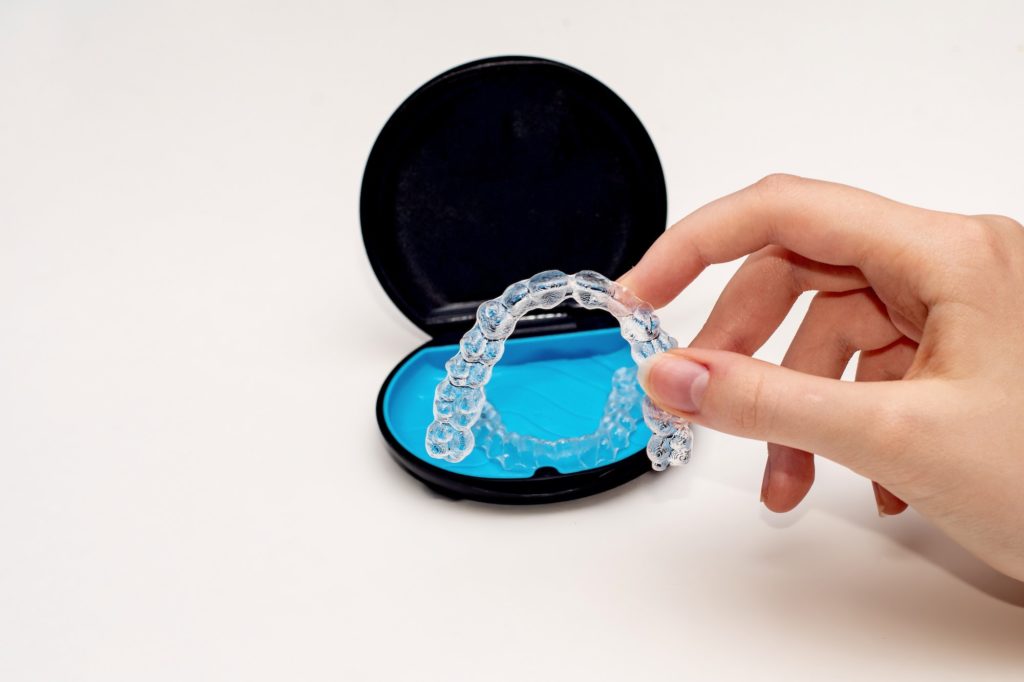6 Things to Know About Braces & Aligners

Discover the benefits and options you have when it comes to getting braces, from braces colors to how quickly you can expect a change in your teeth.
Table of Contents
What Are the Benefits of Having Braces?
There are several benefits to having braces when it’s time to correct your bite and have straighter teeth.
1. Potential alleviation of speech impairments and impediments
Disproportionate teeth have an impact on the way we enunciate and pronounce words.
2. Braces are beneficial in preventing bone erosion due to teeth movement
Misaligned teeth can often lead to bone loss. Bacteria begin to eat away at the bone between teeth. So, braces help move periodontal ligaments by stretching the connective tissues and nerves. Over time, your bones will naturally rebuild once they settle into their new alignment. Having a balanced bite with all teeth in the right position and alignment is a great way of preventing alveolar bone loss, gum disease, and other problems.
3. Braces play a part in aiding your digestion
Braces pull teeth together to create fewer gaps and spaces. This makes it easier to chew food for better digestion.
4. Braces Help Improve Your Overall Oral Health
Excess buildup can lead to gum disease (periodontitis) over time and can often result in bone loss around your teeth, sometimes even tooth loss in advanced stages of the periodontitis. Teeth that are properly spaced and aligned will help keep your entire mouth healthier.
5. Braces can provide a boost in confidence
Braces improve your overall appearance by aligning your teeth for a more aesthetically pleasing result. Having straighter teeth can significantly boost your own feeling of attractiveness and in turn, self-confidence. When you have a smile that you’re proud of, you naturally smile more.
How Quickly Do Teeth Move with Braces?
You can expect to see some noticeable movement around two months into having braces. Some people notice it much sooner, sometimes as fast as four weeks. Since braces apply constant pressure, it will feel like they may be moving all the time, but your teeth will not actually move every day. You’ll probably notice your teeth and gums are a little bit sore for a few days after an adjustment while your teeth get used to the new pressure. By the end of the first month, you could see that your teeth have moved a little bit. Know that each time you get your braces adjusted, your teeth will move just a little more. After several months, there will be significant movement, and other people you know may notice your teeth have moved and are already looking better!
Is it Painful to Wear Braces?
Braces can be slightly uncomfortable or even cause some minor pain while you’re wearing them. Usually, people will only feel pain or discomfort when an orthodontist first fits them and typically after regular brace tightening. But, with that pain or discomfort comes progress. They may also feel pain if part of the brace is rubbing or poking into the inside of their mouth.
Do Braces Change Your Face Shape?
The short answer is no, braces do not change the shape of your face. They can adjust the width of your upper jaw when aligning teeth, but they do not extend into structures that affect the size or shape of other attributes. The shape of your face can, however, become slightly distorted by any type of bite issues or misalignment of the teeth. Aligning the jaw and teeth with braces or Invisalign will give you a stunning, healthy smile. Since your smile is such an important aspect of your face, they can change your appearance in a positive way.
How Much Do Braces Cost?
The cost of braces can vary based on the material used, how long treatment is needed, and the extent of the issue being corrected by your doctor. Here is a national average for reference:
Types of braces and their National Average cost*
- Metal (traditional) braces: $4,000 – $7,500
- Ceramic braces: $4,500 – $8,000
- Lingual braces: $6,000 – $10,000
- Clear aligners (Invisalign): $3,000 – $9,000
*Costs estimated on National Averages June, 2022
Although the low end for Invisalign and clear aligners can be less expensive than other types of braces, that is typically the cost of replacement retainers or minor corrections. Invisalign is usually more expensive than traditional braces because of the lab fees involved in creating the aligners and the use of high-quality materials and technology to perform the treatment. So, simply put, Invisalign is usually more expensive than traditional orthodontic procedures but also more aesthetically pleasing and comfortable for many patients.
Where Can I Get Braces Near Me?
It’s best to speak to your regular dentist about the options that make sense for you. Sometimes, your dentist can perform the orthodontics you need right in their office! In other cases, he or she may refer you to an Orthodontist in the area. No matter which case is right for you, you’ll be sure to get the care you need!
Braces FAQs
Braces are orthodontic appliances that correct dental misalignments and improve oral health and aesthetics. They consist of brackets, usually made of metal or ceramic, bonded to the teeth and connected with wires and elastic bands. The teeth are progressively moved into normal alignment due to the braces’ moderate pressure. This treatment helps address issues like crooked teeth, overcrowding, gaps, and bite problems such as overbites and underbites. By undergoing orthodontic treatment, patients can achieve a straighter and more attractive smile, enhanced chewing function, and overall dental well-being.
The duration of orthodontic treatment with braces varies depending on the individual’s dental condition and the complexity of the corrections required. Typically, they take anywhere from 1 to 3 years to work effectively. During this time, they gradually shift the teeth into their desired positions through controlled pressure and periodic adjustments by the orthodontist.
Regular check-ups and adherence to the orthodontist’s recommendations, such as wearing rubber bands or retainers, are essential to achieve the best results in the shortest possible time. While the treatment duration may seem lengthy, the end outcome of a beautifully aligned and healthier smile makes it well worth the investment.
The usual side effects of braces are typically temporary and may include some discomfort or soreness in the mouth after getting them or following adjustments. The brackets and wires can irritate the cheeks, lips, and tongue, causing mild sores. Eating soft foods and using orthodontic wax can help alleviate this discomfort. Additionally, they may temporarily affect speech, causing slight lisping or difficulty pronouncing certain words, but this usually improves with time as the mouth adjusts.
In some cases, patients may experience a feeling of pressure on the teeth during the initial phases of treatment. Overall, these side effects are manageable and part of the adjustment process as they gradually work to align the teeth properly.
